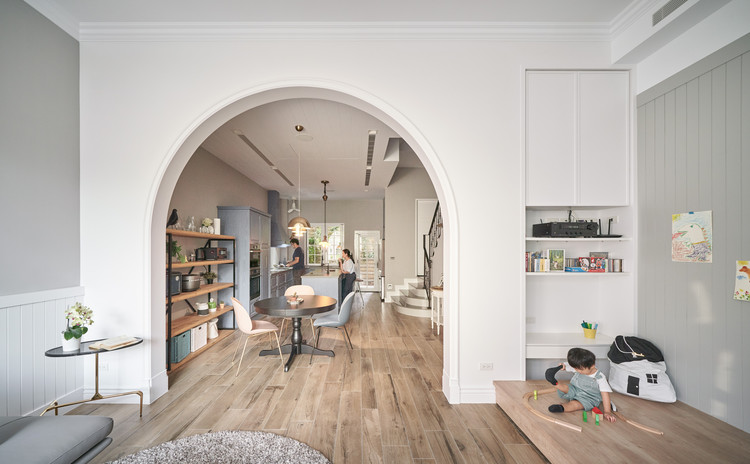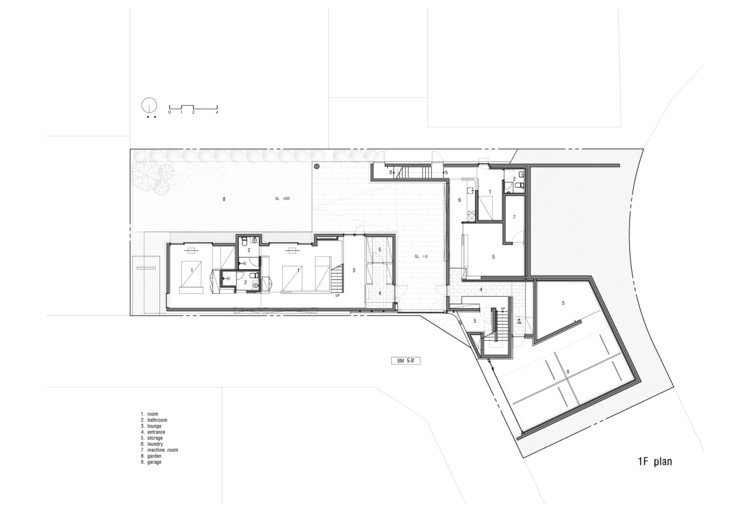AD Classics Azadi Tower Hossein Amanat
2018-09-30 16:30
1966年,国王急于展示石油勘探所产生的财富,并与过去的政治动荡保持距离,举行了一次竞赛,以纪念他的统治,并纪念赛勒斯大帝统治下的阿契梅尼德帝国成立2500周年。建筑师侯赛因·阿曼特(Hossein Amanat)刚从德黑兰大学(University of德黑兰)毕业时就了解到了这一竞争,他放弃了在美国继续学习的计划,而是在自己的卧室里组建了一个小型建筑工作室,为这座纪念碑进行设计。在几个还在上学的朋友的帮助下,阿曼纳特的设计-灵感来自他对波斯历史的迷恋-赢得了比赛。
In 1966, the Shah, eager to display the wealth generated from oil exploration, and to distance himself from past political turmoil, held a competition to design a monument to commemorate his rule, and the 2500th anniversary of the founding of the Achaemenid Empire under Cyrus the Great. Architect Hossein Amanat had just graduated from the University of Tehran when he learned about the competition, and he abandoned plans to continue his studies in the United States, instead forming a small architecture studio in his bedroom to work on a design for the monument. With the help of a few friends who were still in school, Amanat’s design–inspired by his fascination with Persian history–won the competition.
In 1966, the Shah, eager to display the wealth generated from oil exploration, and to distance himself from past political turmoil, held a competition to design a monument to commemorate his rule, and the 2500th anniversary of the founding of the Achaemenid Empire under Cyrus the Great. Architect Hossein Amanat had just graduated from the University of Tehran when he learned about the competition, and he abandoned plans to continue his studies in the United States, instead forming a small architecture studio in his bedroom to work on a design for the monument. With the help of a few friends who were still in school, Amanat’s design–inspired by his fascination with Persian history–won the competition.
© flickr user: froderamone, licensed under CC BY 2.0
(C)Flickr用户:Froderamone,CC by 2.0许可
阿曼拉特将这一设计描述为他在建筑学校学到的所有东西以及他在伊朗各地旅行中所学到的东西的顶峰,并引用了许多历史先例作为影响因素。这座塔的主拱门将前伊斯兰遗址的抛物线拱形与伊斯兰时期尖尖的拱门结合在一起,包裹了几千年的波斯历史。为了调和这两个拱形,阿曼纳特从历史上的波斯建筑中发现的美丽细腻的斜视中汲取了灵感。即使是塔顶的窗户也会受到历史上塔结构相似特征的影响。
Amanat describes the design as the culmination of everything he had learned in architecture school, and in his travels around Iran, citing many historical precedents as influences. The main archway of the tower combines the parabolic arch of the pre-Islamic ruins at Ctesiphon with the pointed arches of the Islamic period, encapsulating millennia of Persian history. To reconcile the two arch shapes, Amanat took inspiration from the beautifully detailed squinches found in historic Persian architecture. Even the windows at the top of the tower are influenced by similar features in historic tower structures.[1]
Amanat describes the design as the culmination of everything he had learned in architecture school, and in his travels around Iran, citing many historical precedents as influences. The main archway of the tower combines the parabolic arch of the pre-Islamic ruins at Ctesiphon with the pointed arches of the Islamic period, encapsulating millennia of Persian history. To reconcile the two arch shapes, Amanat took inspiration from the beautifully detailed squinches found in historic Persian architecture. Even the windows at the top of the tower are influenced by similar features in historic tower structures.[1]
© rasoulali / Shutterstock.com
c.rasoulali/Shutterstock.
为了帮助实现天野之弥的复杂几何学,阿罗普被聘为结构工程师。为了应对形式和地震活动所带来的挑战,这座塔是用加固的、浇筑在现场的混凝土建造的,覆盖着闪闪发光的白色大理石。由于塔的拱和曲线的复杂性,几乎每一块石材包层的形状都是独一无二的。
To help realize the complex geometry of Amanat’s vision, Arup was hired as the structural engineer. To address the challenges of the both the form and the seismically active location, the tower was constructed of reinforced, poured-in-place concrete, clad in glistening white marble. Because of the complexity of the arches and curves of the tower structure, the shape of nearly every piece of the stone cladding was unique.[2]
To help realize the complex geometry of Amanat’s vision, Arup was hired as the structural engineer. To address the challenges of the both the form and the seismically active location, the tower was constructed of reinforced, poured-in-place concrete, clad in glistening white marble. Because of the complexity of the arches and curves of the tower structure, the shape of nearly every piece of the stone cladding was unique.[2]
via Public Domain, Wikimedia Commons
这座塔于1971年建成,最初被称为沙哈德塔(字面意思是“国王纪念碑”)。它是德黑兰最大的广场的聚焦点,也是世界上最大的广场之一,面积超过12万平方米。[3]该建筑群还包括一个地下博物馆,陈列着波斯历史的展品和文物。
The tower was completed in 1971, and originally known as the Shahyad (literally “King’s Memorial”) Tower. It is the focal point of the largest plaza in Tehran, and one of the largest plazas in the world, at over 120,000 square meters.[3] The complex also includes an underground museum housing displays and artifacts of Persian history.
The tower was completed in 1971, and originally known as the Shahyad (literally “King’s Memorial”) Tower. It is the focal point of the largest plaza in Tehran, and one of the largest plazas in the world, at over 120,000 square meters.[3] The complex also includes an underground museum housing displays and artifacts of Persian history.
建成仅仅几年后,这座塔就成了反对沙阿政权的示威活动的焦点。1979年革命后,一些人预计这座塔将被摧毁。正如结构工程师迈克尔-邓肯爵士所描述的,“因为它是国王的偶像,他的主题,我更希望它在镜头前被仪式摧毁。但事实上,就像所有的革命一样,他们是民族的,人民的意志是一个因素。人们喜欢它。领导人不会在人民的眼里吐口水,所以他们重新命名它。[4]今天,这座塔被称为阿扎迪(“自由”)塔,它仍然是国家庆祝活动和抗议活动的集合点,包括2009年总统选举后所谓的绿色革命的大规模示威活动。
Only a few years after its completion, the tower became the focal point for demonstrations against the Shah’s regime. Following the 1979 revolution, some expected the tower to be destroyed. As structural engineer Sir Michael Duncan described, “Because it was the Shah’s icon, his motif, I rather expected it to be ritually destroyed in front of the cameras. But in fact, it turned out like all revolutions, they are national, and the people’s will is a factor. The people loved it. The leaders were not going to spit in the eye of the people, so they’ve rebranded it.”[4] Today the tower is known as the Azadi (“Freedom”) Tower, and it continues to be a rallying point for national celebrations, and protests, including the massive demonstrations of the so-called Green Revolution in the aftermath of the 2009 Presidential elections.
Only a few years after its completion, the tower became the focal point for demonstrations against the Shah’s regime. Following the 1979 revolution, some expected the tower to be destroyed. As structural engineer Sir Michael Duncan described, “Because it was the Shah’s icon, his motif, I rather expected it to be ritually destroyed in front of the cameras. But in fact, it turned out like all revolutions, they are national, and the people’s will is a factor. The people loved it. The leaders were not going to spit in the eye of the people, so they’ve rebranded it.”[4] Today the tower is known as the Azadi (“Freedom”) Tower, and it continues to be a rallying point for national celebrations, and protests, including the massive demonstrations of the so-called Green Revolution in the aftermath of the 2009 Presidential elections.
via Public Domain, Wikimedia Commons
阿曼特没那么幸运。作为巴哈教教徒和犹太人后裔,他在新成立的伊斯兰共和国面临迫害。对他的指控包括,在塔的每个主要正面使用九扇窗户是巴哈教的象征。[5]阿马纳特被迫逃离伊朗,定居在加拿大,继续在那里练习建筑。
Amanat was not as lucky. As a member of the Baha’i faith, and of Jewish descent, he faced persecution in the newly formed Islamic Republic. Allegations against him included accusations that the use of nine windows on each of the main facades of the tower was a Baha’i symbol.[5] Amanat was forced to flee Iran, settling in Canada, where he continues to practice architecture.
Amanat was not as lucky. As a member of the Baha’i faith, and of Jewish descent, he faced persecution in the newly formed Islamic Republic. Allegations against him included accusations that the use of nine windows on each of the main facades of the tower was a Baha’i symbol.[5] Amanat was forced to flee Iran, settling in Canada, where he continues to practice architecture.
不幸的是,路透社2013年的一份报告指出,这座塔最近一直受到忽视,包括天花板开裂、水损坏和墙壁剥落。最近的修理破坏了排水系统,加剧了建筑物的水损坏。有关官员表示,修复工作正在计划之中,但报道发现,以前的维修是用低质量的材料进行的,这让人怀疑未来任何努力的有效性。
Unfortunately, a 2013 report from Reuters indicated that the tower has recently been suffering from neglect, including cracked ceilings, water damage, and peeling walls. Recent repairs had damaged the drainage system, exacerbating water damage in the structure. Officials indicated that repairs were being planned, but the story found that previous repairs had been carried out with low quality materials, raising doubts about the effectiveness of any future efforts.
Unfortunately, a 2013 report from Reuters indicated that the tower has recently been suffering from neglect, including cracked ceilings, water damage, and peeling walls. Recent repairs had damaged the drainage system, exacerbating water damage in the structure. Officials indicated that repairs were being planned, but the story found that previous repairs had been carried out with low quality materials, raising doubts about the effectiveness of any future efforts.
© flickr user: kosoof, licensed under CC BY-NC 2.0
(C)flickr用户:koma of,由-nc2.0颁发CC许可证
在温哥华的Amanat的办公室,2009年的抗议活动中,数千示威者包围的这座塔的放大照片挂在墙上。在2011年BBC波斯语采访中,他描述了他对这一场景的反应:“那天,当这些人聚集在这座建筑的前面时,有人问我,“你觉得怎么样?”好像一个父亲拥抱他们一样。父亲温暖的拥抱。在那住了两三年的父亲。很久了。这是因为伊朗,与我无关。”
In Amanat’s office in Vancouver, an enlarged photograph of the tower during the 2009 protests, surrounded by thousands of demonstrators, hangs on the wall. In a 2011 interview for BBC Persian, he described his reaction to that scene: “That day, as these people gathered in front of this building, someone asked me, ‘how do you feel?’ It was as if a father was embracing them. A father’s warm embrace. A father who had been there for two or three thousand years. That long. This is because of Iran; it has nothing to do with me.”
In Amanat’s office in Vancouver, an enlarged photograph of the tower during the 2009 protests, surrounded by thousands of demonstrators, hangs on the wall. In a 2011 interview for BBC Persian, he described his reaction to that scene: “That day, as these people gathered in front of this building, someone asked me, ‘how do you feel?’ It was as if a father was embracing them. A father’s warm embrace. A father who had been there for two or three thousand years. That long. This is because of Iran; it has nothing to do with me.”
[1]“Az Shahyaad TAA Aazaadi,德黑兰的Icon;如Hossein Amanat所述。”BBC波斯语,2011年。http:/www.amanatArchitecture t.com/visual/visual.html。2015年10月1日查阅。
[1] “Az Shahyaad taa Aazaadi, Tehran’s Icon; As told by Hossein Amanat.” BBC Persian, 2011. http://www.amanatarchitect.com/video/video.html. Accessed October 1, 2015.
[1] “Az Shahyaad taa Aazaadi, Tehran’s Icon; As told by Hossein Amanat.” BBC Persian, 2011. http://www.amanatarchitect.com/video/video.html. Accessed October 1, 2015.
Image of Azadi Tower via shutterstock.com
Image of Azadi Tower via shutterstock.com
Image of arch detail via shutterstock.com
Image of arch detail via shutterstock.com
建筑师Hossein Amanat Location Azadi Tower,德黑兰,伊朗结构工程师Arup Project 1971照片rickyd/Shutterstock.com,flickr user:kco-of,由CC认证-NC 2.0,rasoulali/Shutterstock.com,flickr用户:frederamone,在CC by 2.0类古迹许可下
Architects Hossein Amanat Location Azadi Tower, Tehran, Tehran, Iran Structural Engineer Arup Project Year 1971 Photographs rickyd / Shutterstock.com, flickr user: kosoof, licensed under CC BY-NC 2.0, rasoulali / Shutterstock.com, flickr user: froderamone, licensed under CC BY 2.0 Category Monuments
Architects Hossein Amanat Location Azadi Tower, Tehran, Tehran, Iran Structural Engineer Arup Project Year 1971 Photographs rickyd / Shutterstock.com, flickr user: kosoof, licensed under CC BY-NC 2.0, rasoulali / Shutterstock.com, flickr user: froderamone, licensed under CC BY 2.0 Category Monuments
 举报
举报
别默默的看了,快登录帮我评论一下吧!:)
注册
登录
更多评论
相关文章
-

描边风设计中,最容易犯的8种问题分析
2018年走过了四分之一,LOGO设计趋势也清晰了LOGO设计
-

描边风设计中,最容易犯的8种问题分析
2018年走过了四分之一,LOGO设计趋势也清晰了LOGO设计
-

描边风设计中,最容易犯的8种问题分析
2018年走过了四分之一,LOGO设计趋势也清晰了LOGO设计














































